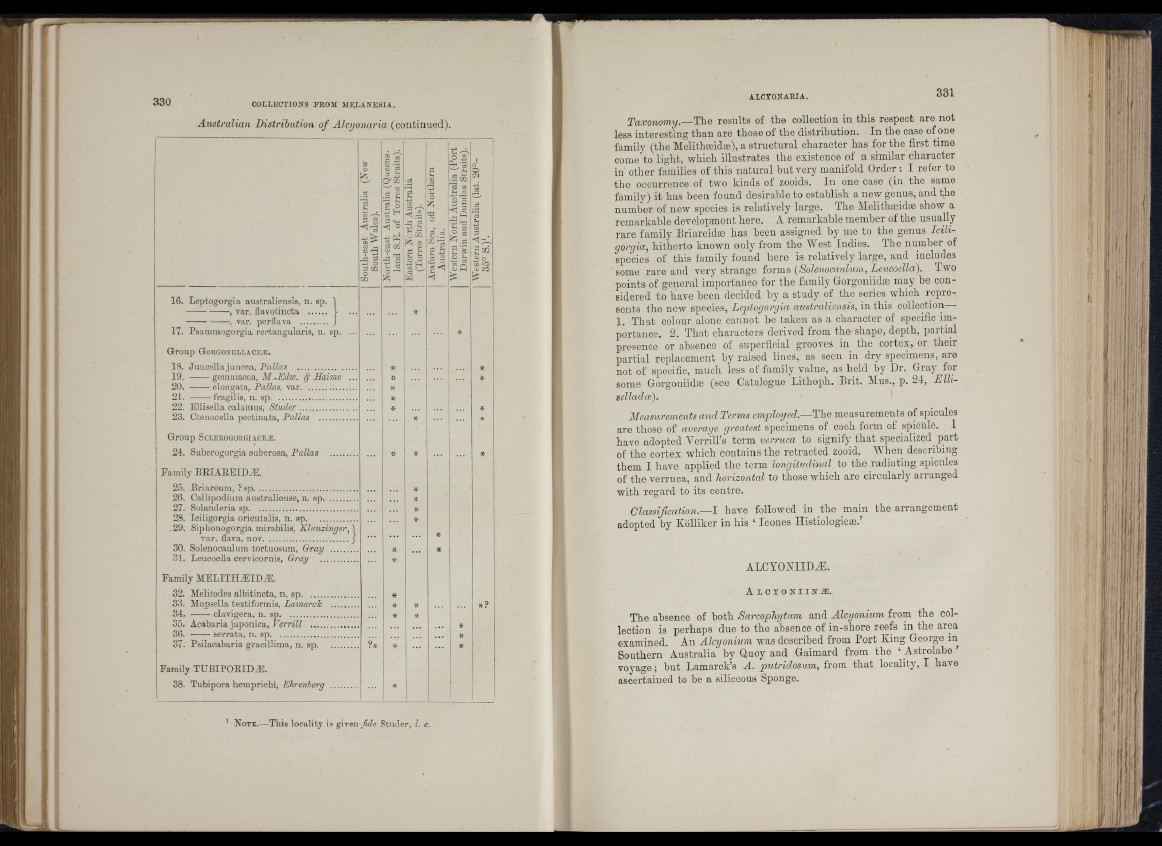
330 COLLECTIONS EROM MELANESIA.
Australian Distribution o f Alcyonaria (continued).
16. Leptogorgia australiensis, n. sp.
------, var. flavotincta .......
-—, var. perflava .........................
17. Psammogorgia rectangularis, n. sp.
Group G o rgonellaceæ.
18. Juncella júncea, Pallas ..................
19. gemmacea, M.-Edw. ÿ Haime
20. elongata, Pallas, var.................
21. fragilis, 11. sp.............................
22. Ellisella calamus, Studer.......................
23. Ctenocella pectinata, Pallas ...............
Group ScLEROGORGIACE.E.
24. Suberogorgia suberosa, Pallas ..........
Family BEIAEEIDÆ.
25. Briareum, ?sp.........................................
26. Callipodium australiense, n. sp.............
27. Solanderia sp...........................................
28. Iciligorgia orientalis, n. sp....................
.29. Siphonogorgia mirabilis, Klunzinger, \
var. flava, nov...................................J
30. Solenocaulum tortuosum. Gray .........
31. LeucoeUa cervicornis, Gray .............
Family MELITIIÆIDÆ.
32. Melitodes albitincta, n. sp.....................
33. Mopsella textiformis, Lamardc .........
34. ---- clavigera, n. sp..............................
35. Acabaría japónica, Verrill .................
36. serrata, n. sp..................................
37. Psilacabaria gracillima, n. sp...............
Family TUBIPORIDÆ.
38. Tubipora bempricbi, Ehrenherg .........
<3^ ’Ia=
t mL
ri o
tiP
"•— sa o ^
ou
-tj A y=i ■ r i O
A:
=0-3
t L S g
? ri
ri
d =3
Cj CQ
l l
ri ri
I "
SY
ti ^ -0OS3J oCiOO
Taxonomy.—The results of the collection in this respect are not
less interesting than are those of the distribution. In the case of one
family (the Alelithteidse), a structural character has for the first time
come”to light, which illustrates the existence of a similar character
in' other families of this natural but very manifold Order ; I refer to
the occurrence of two kinds of zooids. In one case (in the same
family) it has been found desirable to establish a new genus, and the
number of new species is relatively large. The Alelithseidse show a
remarkable development here. Aremarkable member of the usually
rare family Briareida? has been assigned by me to the genus Iciligorgia,
hitherto known only from the West Indies. The number of
species of this family found here is relatively large, and includes
some rare and very strange forms {Solenocaulum, Leucoella). Two
points of general importance for the family Gorgoniidte may be considered
to have been decided by a study of the series which represents
the new species, Leptogorgia australiensis, in this collection—
1. That colour alone cannot be taken as a character of specific importance.
2. That characters derived from the shape, depth, partial
presence or absence of superficial grooves in the cortex, or their
partial replacement by raised lines, as seen in dry specim^ens, are
not of specific, much less of family value, as held by Dr. Gray for
some Gorgoniidie (see Catalogue Lithoph. Brit. Mus., p. 24, E lli-
selladce).
Measurements and Terms employed.—The measurements of spicules
are those of average greatest specimens of each form of spicule. .1
have adopted Yerrill’s term verruca to signify th a t specializcd_ part
of the cortex which contains the retracted zooid. AYhen describing
them I have applied the term longitudinal to the radiating spicules
of the verruca, and Jiorizontcd to those which are circularly aiianged
with regard to its centre.
Classification.— 1 have followed in the main the arrangement
adopted by Kolliker in his ‘ leones Histiologicse.’
ALCYONIIDÆ.
A l c y o n i i n æ .
The absence of both Sarcophytum and Alcyonium from the collection
is perhaps due to the absence of in-shore reefs in the area
examined. An Alcyonium was described from Port King George in
Southern Australia by Quoy and Gaimard from the ‘ Astrolabe ’
voyage ; hut Lamarck’s A . putridosum, from th at locality, I have
ascertained to be a siliceous Sponge.
4.1 '
, 1 ' I
s
V
I li